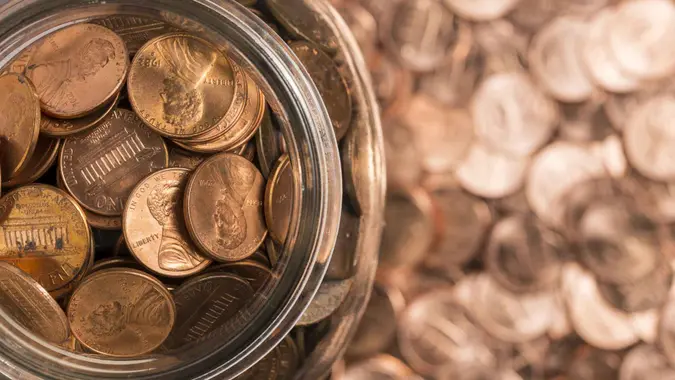6 iPhone Tips To Keep Thieves From Wiping Out Your Bank Account

Commitment to Our Readers
GOBankingRates' editorial team is committed to bringing you unbiased reviews and information. We use data-driven methodologies to evaluate financial products and services - our reviews and ratings are not influenced by advertisers. You can read more about our editorial guidelines and our products and services review methodology.

20 Years
Helping You Live Richer

Reviewed
by Experts

Trusted by
Millions of Readers
When thieves steal iPhones, they’re receiving much more than a pilfered device. The Wall Street Journal reported in February 2023 that iPhones and their passcodes were being stolen across the United States. This gives thieves access to valuable financial information including credit cards stored inside digital wallets and money and account numbers found in bank apps.
How can you protect your confidential financial data and ensure it isn’t drained or wiped by thieves? Start securing your iPhone with the help of these six personal security tips.
Craft a Strong Passcode
One of the first pieces of advice for protecting financial data stored inside an iPhone is to craft a strong passcode on the device.
Dr. Brian Callahan is the graduate program director for the Information Technology & Web Science Program at Rensselaer Polytechnic Institute. For best protection, Callahan recommends choosing an arbitrary-length, alphanumeric passcode. Ideally, this passcode should be 15 characters (at least) in length and not used anywhere else.
Why should you use both letters and numbers for your passcode? According to Callahan, a passcode using only digits means only a numeric keypad appears on the lock screen. However, by adding even one letter or symbol the full keyboard will show at the lock screen. This communicates the probability of a much more complex password to the attacker.
Enable Biometric Authentication
You can also use biometrics, including Face ID and Touch ID, for extra security and to ensure only you are able to unlock your iPhone.
However, Callahan said there are some situations in which biometric technologies cannot be used or even bypassed by thieves. Some of these include an iPhone which has just restarted or too many unsuccessful biometric match attempts.
Utilize Google Authenticator
Several of the cybersecurity experts GOBankingRates spoke to recommended enabling multifactor authentication (MFA) to further protect financial data stored within iPhone devices.
Should you decide to utilize MFA, Callahan recommends avoiding SMS or email-based MFA and using a free authenticator app like Google Authenticator. SMS and email-based MFA are weaker systems compared to Google Authenticator.
Set Up Account Alerts
Chris Hauk, consumer privacy champion at Pixel Privacy, said to set up alerts for any transactions which might be made on your bank or credit card accounts.
“Set the limit very low, as low as one penny, as bad actors will often charge miniscule amounts on accounts to see if the charge goes through,” Hauk recommends. Small deposits, ranging from 20 cents to $10, made in your bank account are often red flags indicating criminals are attempting to hack your account.
Lock Your iPhone
Keep your iPhone locked whenever it’s not in use. If you need to unlock your iPhone in public, Hauk recommends using biometrics, like Face ID, instead of your passcode.
Allison Miller, cybersecurity expert and IANS Faculty member, said an iPhone’s locked screen should also hide details of notifications. Miller recommends going into your notifications settings and setting it so you see that you received a text message, for example, but cannot read the message until you unlock your phone.
Remote Wipe (If Lost or Stolen)
Callahan recommends first making sure your device is backed up to the cloud and conducting remote wipe in the event your device is lost or stolen.
“The Erase Data option will wipe a device after 10 consecutive incorrect passcode attempts,” said Callahan. “Additionally, iCloud allows you to remotely wipe your device. Combined with ensuring good backups to iCloud, this is your best bet: a device with no apps or data on it can’t have that data stolen or those apps used.”
More From GOBankingRates
 Written by
Written by  Edited by
Edited by 

























